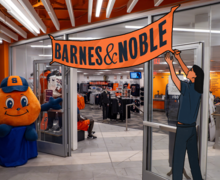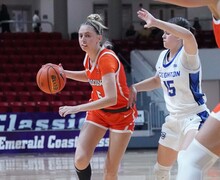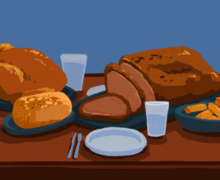HalloQueen Ball brings ballroom culture’s flair to life at SU
Alexander Zhiltsov | Contributing Photographer
The HalloQueen Ball aims to honor and celebrate queer and trans culture and history as part of an initiative by the LGBTQ Resource Center. Participants competed in face, runway and performance categories while spectators danced and cheered them on.
Get the latest Syracuse news delivered right to your inbox.
Subscribe to our newsletter here.
Clapping, encouraging shouts and electronic dance music remixed with “I’m Coming Out” by Diana Ross emanated from the third floor of Schine Student Center. The space, decked out in rainbow streamers, was transformed to host the HalloQueen Ball Saturday night.
Hosted by Syracuse University’s LGBTQ Resource Center, the ball was one of 25 events throughout October to celebrate LGBTQ History Month. Earlier in the month, the center held events such as a Vogue Workshop, a Queer Book Celebration and a Chalk the Quad event in celebration of National Coming Out Day. The ball, hosted by local drag queen Sparkle Royale, helped to bring a glimpse of Syracuse’s ballroom culture scene to campus.
Founded by Black and Latinx trans women in New York City in the 1960s, ballroom culture is an art form where performers “walk” in different categories for a panel of judges, competing in everything from lip-syncing to dancing to modeling.
Throughout the night, attendees had the option to compete in categories including face, runway and performance. Those who didn’t enter a category formed a circle and clapped along to the music as the competitors strutted down the center of the room and toward the panel of five judges made up of ballroom community members and students.
“We’ve been to this event a couple times before,” junior Eleni Cooper said, referring to themself and their friend Serena Peters. “Our other friend is involved in the resource center and we wanted to come out and support her because she’s DJing tonight.”
The two mentioned they are frequent attendees of events hosted by the LGBTQ Resource Center, such as Ace Affinity Group meetings and drag shows, but that the HalloQueen Ball is one of their favorites.
During the face competition, performers were instructed to “serve face,” which, in ballroom culture, means to “deliver a confident, powerful look during a performance.” As they took turns, they were encouraged to get close to the judges and show off their best features.
If the judges held up ten fingers, Sparkle Royale called out “tens across the board,” and the student moved to the next round. If the judges weren’t impressed by the performance, the student was “chopped” and re-joined the crowd.
The same rules applied to the runway and performance categories. During the runway segment, those who chose to compete strutted down through the circle, showing off their best model walk. Some competitors chose to perform solo while others grasped hands with a friend, walking in sync with the claps of the surrounding crowd.
In the final performance round, those competing made sure to put on a show for the audience. Some performers embodied the characters they were dressed as and put on skits for the judges, with one duo dressed as Velma and Daphne from Scooby-Doo silently miming their way through a mystery that needed solving.
Some elected to vogue instead, a style of dance that involves dramatic movements, complicated arm choreography and death-drops.
Even though SU sophomore Meron Berhe didn’t participate in the night’s competitions, she said her experience as an audience member was just as enjoyable.
“It was my first time going to the HalloQueen Ball and it was so much fun. My friends got to compete in some of the categories, so it was great to cheer them on,” Berhe said.
Although the evening’s activities were based on competition, the HalloQueen Ball still fostered a supportive environment. When students who had no experience with ballroom culture got up to perform, the crowd became filled with encouraging cheers. Even when the music stopped working in the middle of a competitor’s runway walk, the audience clapped to a beat so they could finish their performance.
“There’s just a fun freedom, a queer joy of getting to be in a queer space with a bunch of other people,” Peters said. “Like, there’s no judgment, you can wear whatever you want, be whoever you want, and I think that’s really awesome.”
Published on October 22, 2023 at 9:35 pm






